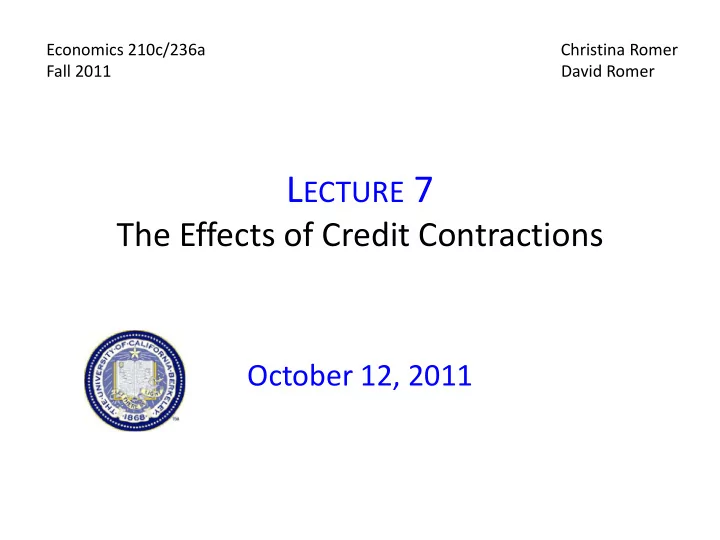

Economics 210c/236a Christina Romer Fall 2011 David Romer L ECTURE 7 The Effects of Credit Contractions October 12, 2011
I. O VERVIEW AND G ENERAL I SSUES
Overview and General Issues A. Gertler & Gilchrist’s motivation: The need for a credit channel B. The gap between the costs of internal and external finance C. Changes in the importance of financial market imperfections D. A special class of firms: Financial institutions E. The importance of general equilibrium considerations F. The credit channel of monetary transmission G. Some terminology: The bank credit channel, the broad credit channel, and the bank capital channel
II. G ERTLER AND G ILCHRIST , “M ONETARY P OLICY , B USINESS C YCLES , AND THE B EHAVIOR OF S MALL M ANUFACTURING F IRMS ”
From: Gertler and Gilchrist, “Monetary Policy, Business Cycles, and the Behavior of Small Manufacturing Firms”
From: Gertler and Gilchrist
From: Gertler and Gilchrist
From: Gertler and Gilchrist
III. C ALOMIRIS AND H UBBARD , “I NTERNAL F INANCE AND I NVESTMENT : E VIDENCE FROM THE U NDISTRIBUTED P ROFITS T AX OF 1936-37”
Calomiris and Hubbard – Issues • Is there a difference in cost between external and internal finance? • Is it caused by asymmetric information or by entrenched managers? • Does the existence of a spread cause investment to depend on cash flow?
From: Calomiris and Hubbard, “Internal Finance and Investment”
Calomiris and Hubbard – Estimating the Cost of External Finance • Baseline case (no other taxes): If a firm uses both internal and external finance and faces a marginal tax rate of τ on retained earnings, we can infer that the shadow cost of external funds to the firm is 1/(1 – τ). • Calomiris and Hubbard’s analysis accounting for taxes, etc.:
From: Calomiris and Hubbard, “Internal Finance and Investment”
From: Calomiris and Hubbard, “Internal Finance and Investment”
From: Calomiris and Hubbard, “Internal Finance and Investment”
Calomiris and Hubbard – Specification (2) (I/K) it = a i + bQ it + c(CF/K) it + e it . (2’) (I/K) i = a 0 + a B D Bi + a C D Ci + b 0 Q i + b B Q i D Bi + b C Q i D Ci + c 0 (CF/K) i + c B (CF/K) i D Bi + c C (CF/K) i D Ci + e i , where D B and D C are dummies for Type B and Type C firms.
From: Calomiris and Hubbard, “Internal Finance and Investment”
IV. P EEK AND R OSENGREN , “C OLLATERAL D AMAGE : E FFECTS OF THE J APANESE B ANK C RISIS ON R EAL A CTIVITY IN THE U NITED S TATES
Peek and Rosengren’s natural experiment : • Financial crisis in Japan causes trouble for banks in U.S. related to Japanese banks (such as U.S. branches of Japanese banks). • Decline in loans by U.S. branches of Japanese banks are almost surely caused by a decline in loan supply not loan demand.
Coefficient on nonperforming loan ratio is negative and significant in two of three states with many Japanese banks, and in the three states combined.
Transmission of Japanese Shocks to U.S. Commercial Real Estate Lending • Panel data on all domestically-owned commercial banks headquartered in one of the three states and Japanese bank branches. • Data are semiannual. • Dependent variable is change in total commercial real estate loans/beginning period assets held by bank in that state.
Testing Whether Conditions at a Japanese Parent Bank Affect Lending
Real Effects of Declines in Japanese Commercial Real Estate Lending • Data are now state level. • Data are still semiannual. • Dependent variable is semiannual change in construction in the state.
Testing Whether Lending Shocks Affect Real Construction Activity
Methodology • Instrument for change in commercial real estate loans by Japanese banks with measures of health of parent bank. • Also uses change in land prices in Japan.
…
Interpreting the coefficient: The 1.113 in column (3) implies that a decline in loans by Japanese banks in a state of $100 lowers the real value of construction projects in that state by $111.30.
V. I VASHINA AND S CHARFSTEIN , “B ANK L ENDING DURING THE F INANCIAL C RISIS OF 2008”
Data • DealScan database of large bank loans • Most are syndicated loans originated by one or more banks. • Measure of the flow of new lending • Ends up aggregating by financial institution (so 38 observations)
What would make a bank more vulnerable to run and so more likely to contract lending? • Raise many funds by short-term debt instead of deposits. • Share credit lines with Lehman Brothers.
Recommend
More recommend